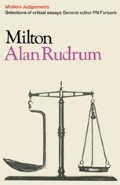Abstract
Scholars have made us conscious of formal rhetoric as a factor in Renaissance poetry: in Tudor and Jacobean lyrics, in Spenserian narrative stanzas, and even in dramatic blank verse. All three contexts of rhetorical usage — lyrical, narrative, dramatic — are to be found in Milton’s poetry; he was the last great practitioner of rhetoric on such a scale before the twentieth century.
Preview
Unable to display preview. Download preview PDF.
Notes
IV (1954) 117–27, 421–30. Cf. I. A. Richards, ‘The Places and the Figures’, in Kenyon Review, XI (1949) 16–30.
Directions for Speech and Style, ed. H. H. Hudson (Princeton, 1935); see P. A. Duhamel, ‘Sidney’s Arcadia and Elizabethan Rhetoric’, in Studies in Philology, XLV (1948) 134–50, for discussion of the prose use of figures.
but see Warren Taylor’s dictionary of Tudor Figures of Rhetoric (Chicago, 1937; privately distributed by University of Chicago Libraries), which also collates Hoskins, Rainolde, Sherry, and Wilson (whom I have consulted) and Charles Butler, Angel Day and Dudley Fenner (I have not read these).
The handiest list is in Veré L. Rubel’s Poetic Diction in the English Renaissance (New York, 1941), which I have found quite the most lucid, practical, and critical book on the subject.
See also D. L. Clark, Rhetoric and Poetry in the Renaissance (New York, 1922)
and W. G. Crane, Wit and Rhetoric in the Renaissance (New York, 1941) and Miss Tuve. I have consulted some studies of other poets’ rhetoric,
such as Sister Miriam Joseph, Shakespeare’s Use of the Arts of Language (New York, 1947); but most have been concerned with the rhetoric of argument or logic — e.g.
Gladys D. Willcock, ‘Shakespeare and Rhetoric’, in Essays and Studies by Members of the English Association, XXIX (1943) 50–61, and Ruth Wallerstein, ‘Rhetoric in the English Renaissance: Two Elegies’ (Donne’s on Prince Henry and ‘Lycidas’), in English Institute Essays, 1948 (New York). Others deal with forensic prose, including W. M. Gilman, Milton’s Rhetoric: Studies in His Defence of Liberty (1939). I am grateful to Miss K. M. P. Burton, fellow of Newnham College, Cambridge, for several suggestions.
E. S. Le Comte, Yet Once More: Verbal and Psychological Pattern in Milton (New York, 1953) p. 25. His chapter 2 gives an introduction to some of Milton’s rhetorical devices under the heading ‘Epic Iteration’, with examples from the Latin poems, which I do not deal with here. Polyptoton is Puttenham’s traductio.
Cf. A. H. Sackton, Rhetoric as a Dramatic Language in Ben Jonson (New York, 1948).
I gesture at Kenneth Burke, The Philosophy of Literary Form (New York, 1941), where he discusses psycholiterary ‘strategies’.
‘Wanderer’, 92. See Adeline C. Bartlett, Larger Rhetorical Patterns in Anglo-Saxon Poetry (New York, 1935).
See Arnold Stein, ‘Structures of Sound in Milton’s Verse’, in Kenyon Review, xv (1953) 266–77, and chapter 6 of his Answerable Style (Minneapolis, 1953). Stein’s critical procedures in reading PL are fundamentally rhetorical.
Editor information
Copyright information
© 1968 Macmillan Publishers Limited
About this chapter
Cite this chapter
BROADBENT, J.B. (1968). Milton’s Rhetoric (1959). In: RUDRUM, A. (eds) Milton. Modern Judgements. Palgrave, London. https://doi.org/10.1007/978-1-349-15255-1_15
Download citation
DOI: https://doi.org/10.1007/978-1-349-15255-1_15
Publisher Name: Palgrave, London
Print ISBN: 978-0-333-09611-6
Online ISBN: 978-1-349-15255-1
eBook Packages: Palgrave Literature & Performing Arts CollectionLiterature, Cultural and Media Studies (R0)

